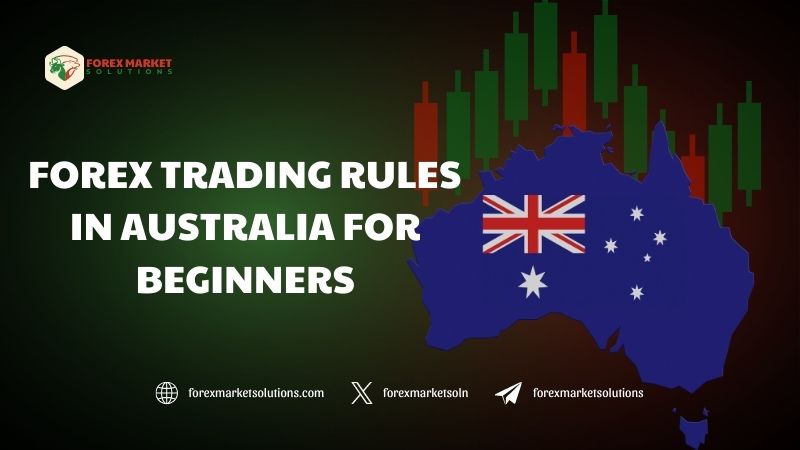Forex trading has surged in popularity across Australia, drawing beginners eager to tap into the world’s largest financial market. In 2025, with its robust economy and favorable trading conditions, Australia offers a welcoming yet regulated environment for those new to currency trading. However, success hinges on understanding the rules that govern this space, ensuring you trade legally and safely. This article delves into Forex trading rules in Australia for beginners, providing a comprehensive guide to the regulatory framework, key requirements, and practical steps to get started. Whether you’re dipping your toes into Forex for the first time or seeking clarity on compliance, this exploration will equip you with the knowledge to navigate Australia’s Forex landscape with confidence and purpose.

The Importance of Regulation in Australian Forex Trading
Australia stands out as a prime destination for Forex trading, thanks to its stable financial system and strict oversight. Regulation is the backbone of this market, designed to protect traders, maintain transparency, and foster fair practices. For beginners, these rules aren’t just legal formalities—they’re a safety net that guards against fraud and ensures your funds are handled responsibly. Grasping Forex trading rules in Australia for beginners is the first step toward building a secure and sustainable trading journey.
The Australian Securities and Investments Commission (ASIC) is the key authority overseeing Forex trading. Known for its rigorous standards, ASIC regulates brokers, enforces compliance, and sets guidelines that align with global best practices while catering to local needs. This balance creates an environment where beginners can trade with peace of mind, knowing that the market operates under a watchful eye. In 2025, as retail trading grows, these regulations remain a critical foundation, offering both protection and opportunity for those starting out.
Core Forex Trading Rules Under ASIC Oversight
The Forex trading rules in Australia for beginners revolve around several core principles enforced by ASIC. One of the most significant is the leverage restriction, introduced to safeguard retail traders. As of 2021, ASIC capped leverage at 30:1 for major currency pairs like AUD/USD and 20:1 for minor pairs, a rule still in place in 2025. This limit reduces the risk of catastrophic losses, especially for novices who might otherwise overextend their positions in pursuit of quick gains. While professional traders can apply for higher leverage, beginners must adhere to these caps, reflecting ASIC’s focus on risk mitigation.
Another vital rule is the requirement for client fund segregation. Brokers must keep your money in separate trust accounts, distinct from their operational funds, ensuring it’s protected if the broker faces financial trouble. This practice, mandated by ASIC, builds trust and stability—crucial for beginners wary of entrusting their capital to a firm. Additionally, brokers are required to hold an Australian Financial Services Licence (AFSL), a rigorous credential that demands adequate capital, qualified staff, and robust risk management systems. These standards ensure you’re dealing with a legitimate entity, a cornerstone of Forex trading rules in Australia for beginners.
Transparency is equally non-negotiable. Brokers must disclose all fees—spreads, commissions, and swap rates—upfront, avoiding hidden costs that could catch new traders off guard. They’re also obligated to provide risk warnings, such as “74-89% of retail investor accounts lose money when trading CFDs,” to educate beginners about the market’s challenges. This openness, paired with negative balance protection (ensuring you can’t lose more than your account balance), creates a framework that prioritizes clarity and safety, helping you start on solid ground.

Licensing and Broker Requirements
To operate legally, Forex brokers in Australia must secure an AFSL, a process that’s both stringent and thorough. ASIC requires firms to maintain a minimum capital base—often $1 million for market-making brokers—along with comprehensive compliance programs. This ensures they can withstand market volatility and honor client withdrawals, a reassurance for beginners relying on their broker’s stability. In 2025, this licensing remains a hallmark of credibility, distinguishing regulated firms from offshore operators that might lack oversight.
For beginners, choosing an ASIC-regulated broker is a practical first step. These firms must adhere to strict reporting standards, submitting regular audits to demonstrate financial health and operational integrity. They’re also subject to dispute resolution mechanisms, like the Australian Financial Complaints Authority (AFCA), which offers recourse if issues arise. Understanding these requirements within Forex trading rules in Australia for beginners helps you select a broker that aligns with legal standards, setting the stage for a secure trading experience.
Forex Trading Rules in Australia for Beginners: Practical Implications
Navigating Forex trading rules in Australia for beginners involves more than just knowing the laws—it’s about applying them to your trading journey. The leverage cap, for instance, shapes how you manage risk. With a 30:1 limit on AUD/USD, a $1,000 account lets you control up to $30,000 in a trade, amplifying gains but also losses. Beginners should start small, risking only 1-2% of their capital per trade, to stay within safe boundaries while learning the ropes. This conservative approach aligns with ASIC’s protective intent, easing you into the market without overwhelming exposure.
Fund safety rules mean you should verify your broker’s segregation practices—check their AFSL status on ASIC’s website and confirm they use reputable banks for client accounts. Transparency rules empower you to compare brokers based on disclosed costs, ensuring you’re not blindsided by fees. Negative balance protection, meanwhile, offers peace of mind—your losses won’t spiral into debt, a critical safeguard as you test strategies in 2025’s volatile conditions. These practical implications turn regulatory knowledge into actionable steps, bridging the gap between rules and real-world trading.

Starting Out: Compliance and Best Practices
For beginners, compliance with Forex trading rules in Australia for beginners starts with selecting the right broker. Look for ASIC-regulated firms like Pepperstone, IC Markets, or FP Markets—established names in 2025 with strong reputations. Open a demo account first, a feature most brokers offer, to practice trading within leverage limits and familiarize yourself with platforms like MetaTrader 5. This risk-free environment lets you explore Forex without breaching rules or losing money, building confidence before going live.
Once ready, fund your account with a modest amount—say, $200—and stick to micro-lots (0.01 lots) to keep risk low. Follow ASIC’s risk warnings by setting stop-losses on every trade, protecting your capital from sudden market swings. Keep a trading journal to track your progress, noting how rules like leverage and fund segregation influence your outcomes. This disciplined approach ensures you’re not just compliant but also growing as a trader, leveraging Australia’s regulated market to your advantage.
Challenges and Opportunities in 2025
Australia’s Forex rules present both hurdles and benefits for beginners. The leverage cap might feel restrictive compared to offshore brokers offering 500:1, tempting some to bypass ASIC regulation. However, this comes with risks—unregulated firms may lack fund protection or oversight, exposing you to fraud. Staying within Forex trading rules in Australia for beginners offers security over speculation, a trade-off worth embracing for long-term success.
Opportunities abound too. In 2025, Australia’s stable economy and proximity to Asian markets create a vibrant Forex scene, with pairs like AUD/JPY thriving. ASIC’s focus on education—through mandated disclosures and broker resources—helps beginners learn faster, while technology like mobile trading apps enhances accessibility. By aligning with these rules, you tap into a market that’s both safe and ripe with potential, setting a strong foundation for your trading career.

Trade Smart in Australia
Mastering Forex trading rules in Australia for beginners is your gateway to a rewarding 2025 trading journey. From ASIC’s leverage caps to fund segregation and transparency, these regulations provide a secure framework that protects and empowers new traders. Start by choosing a licensed broker, practicing on a demo, and trading conservatively—compliance isn’t a barrier but a boost to your success. Embrace these rules, build your skills, and watch your Forex path unfold with clarity and confidence.
Ready to dive into Forex trading in Australia? Follow Forex Market Solutions for expert guides, regulatory insights, and tips to fuel your journey. Join us today and trade with assurance!
